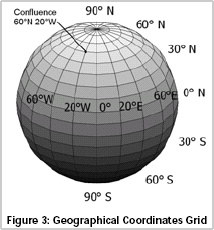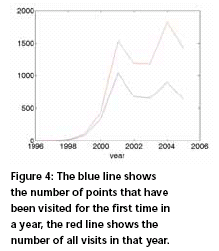| Surveying | |
What does our world really look like?
Equidistribution on the sphereOnly when all degree confluences have been visited will a thorough view of our planet’s surface be possible. One might argue now that all meridians meet at the poles and that pole areas have a higher density of latitudelongitude intersections than the tropical regions. This is du tothe defi nition of geographical coordinates, which are referenced on the WGS84 datum and its underlying Geodetic Reference System 1980 (GRS80) ellipsoid, see Figure 3. As a consequence the distance between degrees of longitude varies considerably between 111.32 km at the equator to 1.95 km at the 89° latitude circle. The distances of latitude circles however do not vary significantly (between 110.57 km at the equator to 111.69 km between 89° latitude to the poles). Whatever coordinate system is used, it is not possible to equally distribute points on the sphere except in a few special cases called the platonic solids like the Tetrahedron or Dodecahedron. More details see Womersley (2005). For the confluence project this problem is solved by excluding some points near the poles and calling them “secondary” while all others are considered as “primary”. Further details can be found on the website of confl ence.org. The futureWill the project ever be completed? Considering it took 10 years to visit 25% of the points, a linear prediction would give a positive answer, but would also suggest a completion in the year 2036, which means another 30 years of hunting unvisited points. Well, some variables make this calculation unreliable. The last remaining unvisited point might be hard to conquer (e.g. imagine trying to visit a confl uence in a military compound in North Korea) or just unattractive to visit (as most of Antarctica seems to be with currently only 5 out of 1718 primary points visited). On the other hand, the project has gained publicity and attracted a rising number of active members. If the whole world population would participate, I guess that all points can be reached within in a couple of days. A realistic forecast can be made by looking at the past. Figure 4 shows how the project developed over the last 10 years. While the number of total visits is still increasing, there is a downward tendency for the number of first visits of confluence points over the last five years. If the downswing continues, a completion in 30 years is doubtful. Here is my idea how one can break all records and visit 360 new confuences in one day (350 of them being secondary): circle the South Pole at the 89° latitude circle on a snowmobile. If you take the required pictures of the confluences (being 1.95 km apart) on-the-fly, the 700km journey can be done on an average speed of 30km per hour. But I guess that realisation face a lot of logistical challenges and also involve some costs. In conclusion I can say that it is currently an open question whether the project goal will be met one day or not. May this article contribute to the awareness of confluences and help to answer this open question someday with: “project completed!”. Womersley, R (2005), Distributing points on the sphere Homepage Articles School of Mathematics, UNSW, http://www.maths.unsw.edu. au/school/articles/me100.html |
|||||||||||||||
|
|||||||||||||||
|
Pages: 1 2














 (No Ratings Yet)
(No Ratings Yet)





